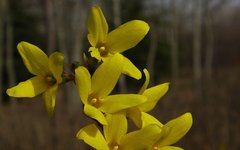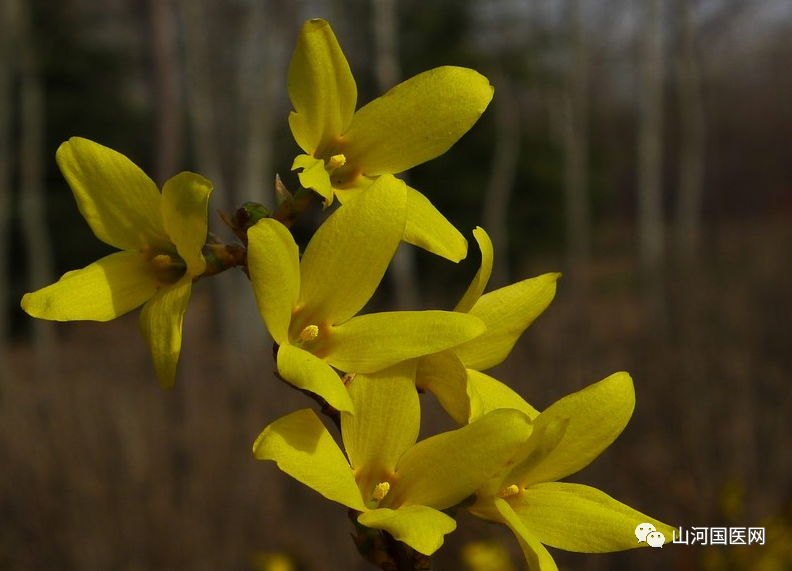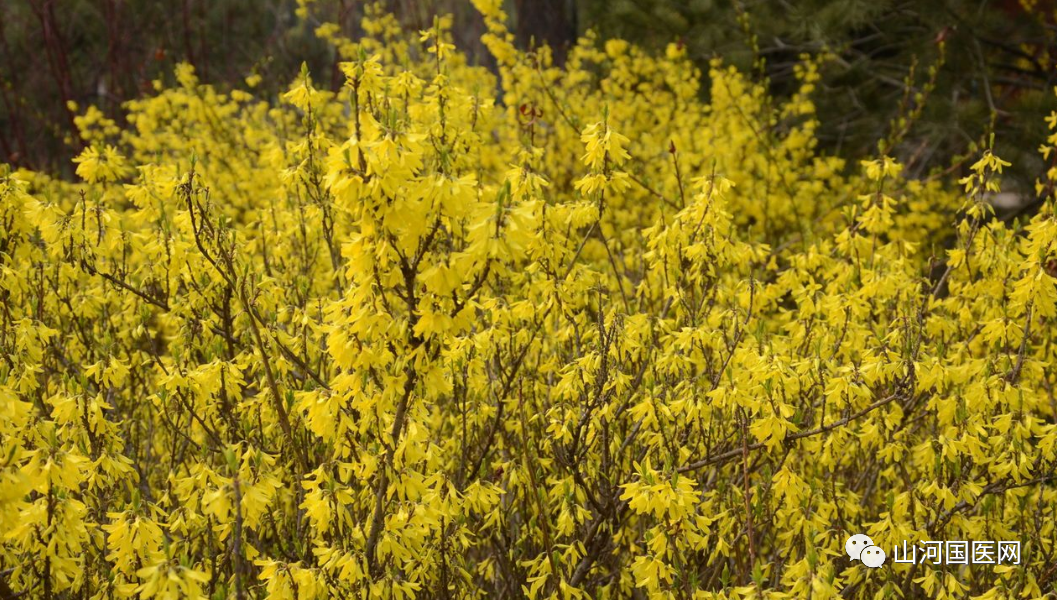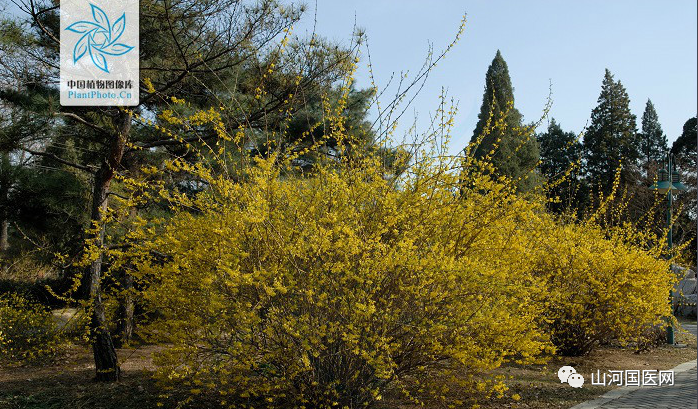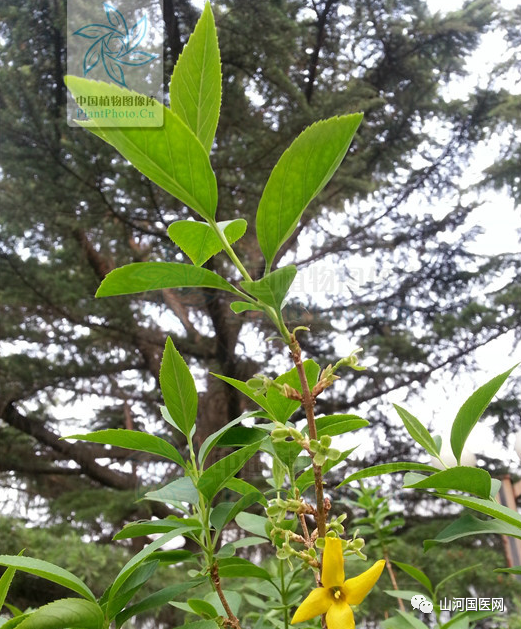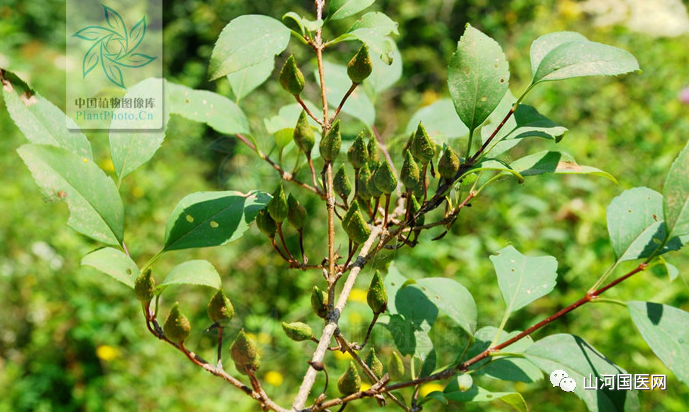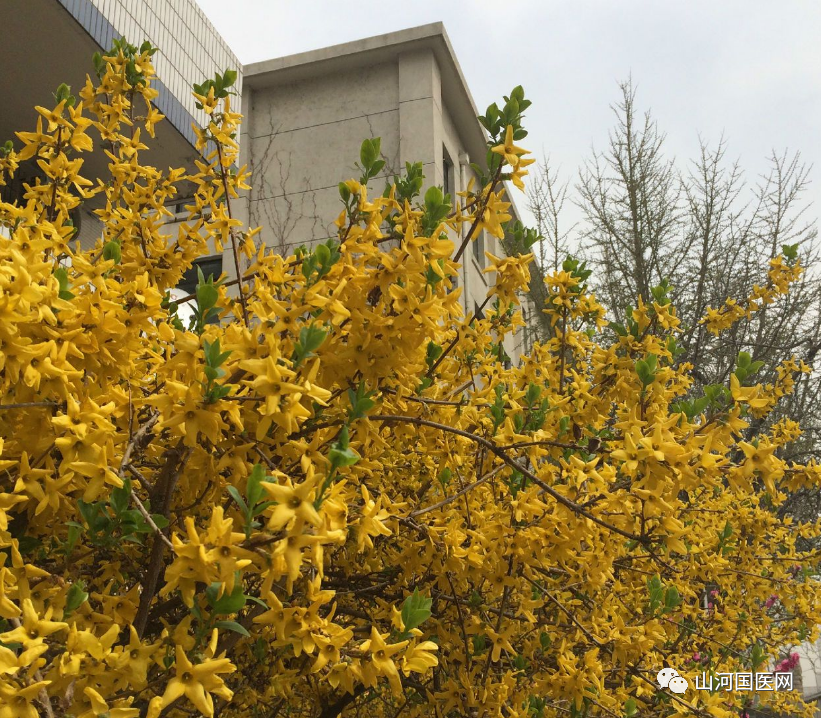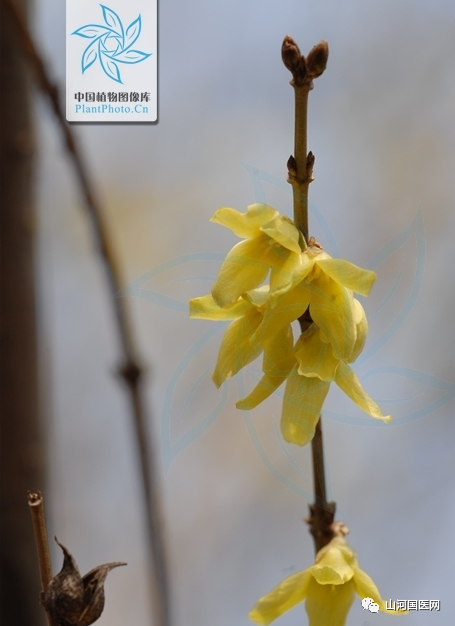| Forsythia Lián Qiáo | |
|---|---|
|
|
|
| Alias | Lián Ké, Huáng Huā Tiáo, Huáng Liàn Tiáo Huā, Huáng Qí Dān, Qīng Qiáo, Luò Qiáo, Hàn Lián Zǐ, Dà Qiáo Zǐ, Kōng Ké, Kōng Qiáo |
| Functions | Clears heat, detoxifies, disperses nodules, reduces swelling. Treats warm heat, erysipelas, rashes, carbuncles, lymphadenitis, and urinary obstruction. |
| First Recorded In | Shennong Bencao Jing |
| Toxicity | Non-toxic |
| Meridians Entered | Heart, Gallbladder, Lung |
| Nature | Cool |
| Taste | Bitter |
Forsythia is one of the commonly used traditional Chinese herbs in clinical practice, also known as Huáng Huā Tiáo, Lián Ké, Qīng Qiáo, Luò Qiáo, and others. The 2005 edition of the Pharmacopoeia of the People’s Republic of China lists Forsythia as the dried fruit of the plant Forsythia suspensa, belonging to the Oleaceae family. The fruit is harvested when it is still green and immature, referred to as Qīng Qiáo, and when fully ripe and yellow, it is called Lǎo Qiáo.Forsythia has antibacterial, cardiotonic, diuretic, and antiemetic pharmacological effects, and is commonly used to treat acute wind-heat cold, carbuncles, skin infections, tuberculosis of lymph nodes, urinary tract infections, and other conditions. It is a key ingredient in various herbal preparations such as Shuang Huang Lian Oral Liquid, Shuang Huang Lian Powder Injection, Qing Re Jie Du Oral Liquid, Lián Cǎo Jie Re Oral Liquid, and Yín Qiáo Jie Du Granules.Basic Information1. Chinese Name: Forsythia2. Mongolian Name: Xī Rì Yī Sū Lóng Gā3. Aliases: Yī Chuàn Jīn, Hàn Lián Zǐ, Huáng Qí Dān, Lián Ké, Huáng Huā Tiáo, Huáng Liàn Tiáo Huā, Qīng Qiáo, Luò Qiáo, Huáng Shòu Dān, Huáng Shòu Dān, Jīn Huáng Tiáo.4. Medicinal Part: Fruit is used medicinally.5. Collection and Processing: Harvest in autumn when the fruit is still green, remove impurities, steam, and dry (Qīng Qiáo); harvest when the fruit is fully ripe, remove impurities, and dry (Lǎo Qiáo); collect seeds (Lián Qiáo Xīn).6. Taste and Function: The herb is bitter and slightly cold.Clears heat and detoxifies, disperses nodules, and reduces swelling. The Mongolian version is bitter and cool. Clears “Xie Rì”, stops diarrhea.7. Indications: Used in TCM for initial stages of febrile diseases, wind-heat colds, fever, irritability, sore throat, rashes, erysipelas, lymphadenitis, carbuncles, acute nephritis, and heat stranguria. The Mongolian version treats jaundice, intestinal pain, “Xie Rì” disease, and intestinal heat.8. Dosage and Administration: 6-9 grams of the herb, decocted in water, or made into pills or powders. The Mongolian version is used in pills, powders, or decoctions.9. Precautions: Use with caution in cases of already ruptured carbuncles.There are 11 major varieties worldwide, most originating from China, with some from Korea and Japan, and only one from southern Europe. The name Forsythia commemorates the Scottish botanist William Forsyth.In China, the varieties are mostly the dried fruits of the plant Forsythia suspensa from the Oleaceae family. In mainland China, it is distributed in provinces such as Hebei, Shanxi, Shaanxi, Gansu, Ningxia, Shandong, Jiangsu, Henan, Jiangxi, Hubei, Sichuan, and Yunnan. The fruit is harvested in autumn when it is still green, removed of impurities, steamed, and dried, commonly referred to as “Qīng Qiáo”; when fully ripe, it is dried and referred to as “Lǎo Qiáo”. The capital city of South Korea, Seoul, has Forsythia as its city flower.[Processing] Remove impurities, crush, and remove stems.[Taste and Nature] Bitter, slightly cold.①《Bencao Jing》: Bitter taste, neutral.②《Bielu》: Non-toxic.③《Yixue Qiyuan》: “Main Treatment Secrets” states it is cool and bitter.④《Gangmu》: Slightly bitter and pungent.[Meridians Entered] Enters the Heart, Lung, and Small Intestine meridians.①《Tangye Bencao》: Hand and foot Shaoyang, Yangming meridians.②《Gangmu》: Shaoyin Heart meridian, Jueyin pericardium Qi level.③《Leigong Paozhi Yaoxing Jie》: Enters the Heart, Liver, Gallbladder, Stomach, Sanjiao, and Large Intestine meridians.[Functions and Indications – Effects of Forsythia] Clears heat and detoxifies, reduces swelling and disperses nodules, disperses wind-heat, known as the “Holy Medicine for Sores”.Treats warm heat, erysipelas, rashes, carbuncles, lymphadenitis, urinary obstruction, and clears heart fire.①《Bencao Jing》: Treats cold and heat, mouse paralysis, lymphadenitis, carbuncles, ulcers, goiter, and heat accumulation.②《Bielu》: Eliminates white worms.③《Yaoxing Lun》: Treats and facilitates the five lin, urinary obstruction, and removes heart heat.④《Rihua Zibencao》: Unblocks the small intestine, expels pus.Treats sores and boils, relieves pain, and regulates menstruation.⑤ Li Gao: Disperses blood stasis and qi stagnation; reduces swelling.⑥ Wang Haogu: Treats deafness and tinnitus.[Dosage and Administration] Internal use: Decoction, 9-15 grams; or made into pills or powders. External use: Decoction for washing.[Indications and Contraindications] Contraindicated in cases of spleen and stomach deficiency, qi deficiency with fever, and ruptured carbuncles with thin pus.①《Bencao Jing Shu》: Do not use if carbuncles have ruptured, do not use for heat due to deficiency, and do not use for those with weak spleen and stomach prone to diarrhea.②《Bencao Tongxuan》: Long-term use may lead to cold-related issues.[Selected Formulas] ① For Taiyin wind warmth, warm heat, warm epidemic, and initial stages with heat but no aversion to cold and thirst: Forsythia 30 grams, Honeysuckle 30 grams, Bitter Platycodon 18 grams, Peppermint 18 grams, Bamboo Leaves 12 grams, Raw Licorice 15 grams, Mustard Seed 12 grams, Fermented Soybean 15 grams, Burdock Seed 18 grams. Grind into powder, take 18 grams each time, decoct with fresh reed root, and take when fragrant, do not overboil. For severe cases, take twice a day; for mild cases, take three times a day; if symptoms persist, repeat the dose.(《Wenbing Tiaobian》Yin Qiao San) ② For all types of heat in children: Forsythia, Fangfeng, Licorice (roasted), and Gardenia in equal parts. Grind into powder, take 6 grams each time, decoct with 200 ml of water, and take warm after straining.(《Leizheng Huoren Shu》Forsythia Decoction) ③ For red rashes and toxic conditions: Forsythia alone, decoct and drink.(《Yuqiao Yiling》) ④ For breast abscess and lumps: Forsythia, male mouse droppings, Dandelion, and Fritillaria each 6 grams. Decoction for oral administration.(《Yuqiao Yiling》) ⑤ For lymphadenitis that does not resolve: Forsythia, Ghost Arrow Leaf, and Plantago, and Licorice (roasted) in equal parts. Grind into fine powder, take 6 grams with rice water before bed.(《Yangshi Jiazang Fang》Forsythia Powder) ⑥ For tongue ulcers: Forsythia 30 grams, Huangbai 15 grams, Licorice 6 grams. Decoct and gargle.(《Yuqiao Yiling》)[Clinical Applications] ① For treating acute nephritis, take 18 grams of Forsythia, add water and simmer until 150 ml, divide into three doses before meals, reduce for children. Depending on the condition, take for 5-10 days, avoiding spicy foods and salt. In 8 patients, all had edema, blood pressure between 140-200/96-110 mmHg, and urine tests showed protein, granular casts, and red and white blood cells. After treatment, 6 cases of edema completely resolved, 2 cases significantly improved; blood pressure decreased significantly; urine tests showed 6 cases turned negative, 2 cases improved.② For treating purpura, take 18 grams of Forsythia, add water and simmer to 150 ml, divide into three doses before meals, avoiding spicy foods. Treated 1 case of thrombocytopenic purpura and 2 cases of allergic purpura. After 2-7 days of treatment, all skin purpura resolved. The effect of Forsythia may be related to its high content of rutin, which helps maintain normal capillary resistance, reducing capillary fragility and permeability; additionally, Forsythia seems to have a desensitizing effect.③ For treating lung abscess, prepare Forsythia as an injection, with 1 gram of Forsythia per milliliter. Use tracheal drip combined with intramuscular injection. Tracheal drip generally uses 6-10 ml, once a day; after symptoms improve, every other day; as symptoms shrink or close, every week twice. Treated 25 cases, cured 14, improved 10, and 1 death; according to 18 cases, the average treatment lasted 12 days with an average of 26.8 tracheal drips, with a maximum of 50 drips.④ For treating retinal hemorrhage, take 18-21 grams of Forsythia, simmer in water, divide into three doses before meals. In 2 cases of retinal hemorrhage in the macular area, after 20-27 days of medication, significant absorption occurred, and vision improved.[Verification] Originates from 《Shennong Bencao Jing》.1. Tao Hongjing: Forsythia is found everywhere, now used for its stem, flower, and fruit.2. 《Tang Bencao》: There are two types of Forsythia, large and small. The large type has narrow long leaves, like water mint, with beautiful yellow flowers, growing in wet places, and its fruit resembles unripe mulberries, producing many seeds. The small type grows on hills, with leaves, flowers, and fruit similar to the large type but smaller and finer, used by people in the south. Now in Beijing, only the large type is used, not the stem and flower.3. 《Bencao Tujing》: Forsythia is found near Beijing and in provinces like Hebei, Jiangning, and others. There are large and small types. The large type grows in wet places or hills. The leaves are green and narrow, like elm leaves or water mint. The stems are red, about three to four feet tall. The flowers are beautiful yellow, and the fruit resembles lotus seeds, producing many seeds, hence the name. The roots are yellow like mugwort roots, harvested in August and dried in the shade. The small type grows on hills, with leaves, flowers, and fruit similar to the large type but finer. The southern variety has narrow and small leaves, short stems, only one or two feet tall. The flowers are also yellow, and the fruit is yellow-black, containing black seeds like millet, also known as Hàn Lián Cǎo, used by southern people for its flowers and leaves. Now southern TCM practitioners say there are two types of Forsythia, one resembling unripe mulberries, with a small hard shell and no attached calyx, which when cut open releases a strong fragrance, while the other resembles a lotus, with a soft shell, surrounded by a calyx, with no fragrance, and even when dried for a long time, it remains attached to the stem, which is very different. The lotus-like type is very common in southern Jiangnan. The unripe mulberry type comes from Sichuan, and its use is superior to that from Jiangnan. However, the stem and leaf characteristics are not yet known.
Various Discussions
1) 《Shennong Bencao Jing》: Treats cold and heat, mouse paralysis, lymphadenitis, carbuncles, ulcers, goiter, heat accumulation, and poison.2) 《Mingyi Bielu》: Eliminates white worms.3) 《Yaoxing Lun》: Treats and facilitates the five lin, urinary obstruction, and removes heart heat.4) 《Rihua Zibencao》: Unblocks the small intestine, expels pus. Treats sores and boils, relieves pain, and regulates menstruation.5) 《Zhenzhu Nang》: Forsythia has three uses: 1) Clears heart meridian heat; 2) Eliminates upper jiao heat; 3) Known as the holy medicine for sores.6) Li Gao: Disperses blood stasis and qi stagnation; reduces swelling.7) Wang Haogu: Treats deafness and tinnitus.
Forsythia and Jasmine
Forsythia and Jasmine are not the same plant; although both belong to the Oleaceae family, Jasmine is from the genus Jasminum, with the scientific name: Jasminum mudiflorum; while Forsythia is from the genus Forsythia, with the scientific name: Forsythia suspensa (Thunb.) Vahl.The main differences between Forsythia and Jasmine are:1) Jasmine is from the Oleaceae family and is shrub-like, smaller, with arching branches that easily droop; Forsythia is from the Oleaceae family and is shrub-like or tree-like, larger, with branches that do not easily droop;2) Jasmine’s young branches are green, while Forsythia’s are darker, generally light brown;3) Jasmine’s branches are solid, with pith; Forsythia’s branches are hollow without pith;4) Jasmine has trifoliate leaves, while Forsythia has simple or opposite trifoliate leaves;5) Jasmine leaves grow symmetrically in a cross shape, are small, oval, entire, and pointed; Forsythia leaves are ovate, broad ovate, or elliptic, larger, with regular coarse serrations except at the base;6) Jasmine flowers have six petals, while Forsythia has only four petals;7) Jasmine flowers rarely produce fruit, while Forsythia flowers produce fruit.Disclaimer:The content on this site is added and organized by users for learning and reference purposes only. The information on the site may not be accurate, comprehensive, or up-to-date, and the content should not be the final basis for diagnosing or treating diseases.Shanhe TCM Networkwould like to remind users that if you have any physical discomfort, please seek medical attention promptly. Thank you for your support and love; we will strive to do better~!!!


